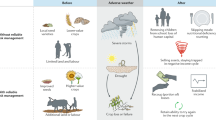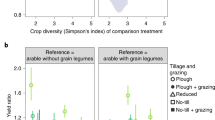Abstract
One key challenge for the twenty-first century is how to produce the food we need, yet ensure the landscape we want. Genetically modified crops have focused our attention on how to answer this question for one part of agriculture. The same principles could be applied to assess environmental impacts of future land-use change in a much broader context.
This is a preview of subscription content, access via your institution
Access options
Subscribe to this journal
Receive 51 print issues and online access
$199.00 per year
only $3.90 per issue
Buy this article
- Purchase on Springer Link
- Instant access to full article PDF
Prices may be subject to local taxes which are calculated during checkout

Similar content being viewed by others
References
Conway, G. & Toenniessen, G. Feeding the world in the twenty-first century. Nature 402, C55–C58 (1999).
Krebs, J. R., Wilson, J. D., Bradbury, R. B. & Sirwardena, G. M. The second Silent Spring? Nature 400, 611–612 (1999).
Crawley, M. J., Hails, R. S., Rees, M., Kohn, D. & Buxton, J. The ecology of transgenic oilseed rape in natural habitats. Nature 363, 620–623 (1993).
Sala, O. E. et al. Global biodiversity scenarios for the Year 2100. Science 287, 1770–1774 (2000).
Trewavas, A. J. & Leaver, C. J. Is opposition to GM crops science or politics? EMBO Rep. 2, 1–5 (2001).
Pimentel, D., Lach, L., Zuniga, R. & Morrison, D. Environmental and economic costs of nonindigenous species in the United States. Bioscience 50, 53 (2000).
Crawley, M. J., Brown, S. L., Hails, R. S., Kohn, D. & Rees, M. The performance of transgenic crops in natural habitats: a 10-year perspective. Nature 409, 682–683 (2001).
Cooper, J. I. in Commercialisation of Transgenic Crops: Risk, Benefit and Trade Considerations (eds McLean, G. D. et al.) 115–124 (Bureau of Resource Sciences, Kingston, ACT, 1997).
Crawley, M. J. Bollworms, genes and ecologists. Nature 400, 501–502 (1999).
Hails, R. S. Genetically modified organisms—the debate continues. Trends Ecol. Evol. 15, 14–18 (2000).
Shea, K. & Chesson, P. What can community theory tell us about biological invasions? Trends Ecol. Evol. 17, 170–176 (2002).
Advisory Committee on Releases to the Environment (ACRE) Sub-group on Wider Biodiversity Issues. Guidance on the Assessment of the Impact on Wider Biodiversity from Proposed Cultivation of GM Crops 〈http://www.defra.gov.uk/environment/acre/biodiversity/guidance/index.htm〉 (31 July 2001).
Firbank, L. G. et al. Farm-scale evaluation of GM crops explained. Nature 399, 727–728 (1999).
Agriculture and Environment Biotechnology Commission. Crops on Trial (DTI, London, 2001)
Watkinson, A. R., Freckleton, R. P., Robinson, R. A. & Sutherland, W. J. Predicting biodiversity responses to GM herbicide tolerant crops. Science 289, 1554–1556 (2000).
Firbank, L. G. & Forcella, F. Genetically modified crops and farmland biodiversity. Science 289, 1481–1482 (2000).
Daily, G. C. et al. The value of Nature and the nature of value. Science 289, 395–396 (2000).
Tilman, D. et al. Forecasting agriculturally driven global environmental change. Science 292, 281–284 (2001).
Sutherland, W. J. Restoring a sustainable countryside. Trends Ecol. Evol. 17, 148–150 (2002).
Beringer, J. E. Farming for biodiversity with GMOs? Outlook Agric. 30, 7–9 (2001).
Phipps, R. H. & Park, J. R. Environmental benefits of genetically modified crops: global and European perspectives on their ability to reduce pesticide use. J. Anim. Feed Sci. 11, 1–18 (2002).
Pretty, J. N. et al. An assessment of the total external costs of UK agriculture. Agric. Syst. 65, 113–136 (2000).
Pidgeon, J. D., Dewar, A. M. & May, M. J. in Proc. BCPC-Weeds 2001, 373–380 (BCPC Publications, Bracknell, 2001).
Marsh, J. Integrated Farm Management—A Farm Strategy for the 21st Century (LEAF, The National Agricultural Centre, Stoneleigh, 2000).
Tilman, D. The greening of the green revolution. Nature 396, 211–212 (1998).
Wilson, P. J. in Field Margins: Integrating Agriculture and Conservation (ed. Boatman, N.) BCPC Monogr. No. 58, 253–258 (BCPC Publications, Bracknell, 1994).
Bakker, J. P. & Berendse, F. Constraints in the restoration of ecological diversity in grassland and heathland communities. Trends Ecol. Evol. 14, 63–68 (1999).
Bobbink, R., Hornung, M. & Roelofs, J. G. M. in Manual on Methodologies and Criteria for Mapping Critical Loads/Levels (UN ECE Convention on Long-range Transboundary Air Pollution), 71–96, III-i-III-54 (Federal Environmental Agency, Berlin, 1996).
Perfecto, I., Rice, R. A., Greenberg, R. & Van der Voort, M. E. Shade coffee: a disappearing refuge for biodiversity. Bioscience 46, 598–608 (1996).
Chamberlain, D. E., Fuller, R. J., Bunce, J. C., Duckworth, J. C. & Shrubb, M. Changes in the abundance of farmland birds in relation to the timing of agricultural intensification in England and Wales. J. Appl. Ecol. 37, 771–788 (2000).
Chamberlain, D. E. & Fuller, R. J. Local extinctions and changes in species richness of lowland farmland birds in England and Wales in relation to recent changes in agricultural land-use. Agric. Ecosyst. Environ. 78, 1–17 (2000).
Gates, S. & Donald, P. F. Local extinction of British farmland birds and the prediction of further loss. J. Appl. Ecol. 37, 806–820 (2000).
Donald, P. F., Green, R. E. & Heath, M. F. Agricultural intensification and the collapse of Europe's farmland bird populations. Proc. R. Soc. Lond. B 268, 25–29 (2001).
Campbell, L. H. et al. A Review of the Indirect Effect of Pesticides on Birds JNCC Report No. 227 (Joint Nature Conservation Committee, Peterborough, 1997).
Wilson, J. D., Morris, A. J., Arroyo, B. E., Clark, S. C. & Bradbury, R. B. A review of the abundance and diversity of invertebrate and plant foods of granivorous birds in northern Europe in relation to agricultural change. Agric. Ecosyst. Environ. 75, 13–30 (1999).
Haines-Young, R. H. et al. Accounting for Nature: Assessing Habitats in the UK Countryside (Department of the Environment, Transport and the Regions, London, 2000).
Smart, S. M., Firbank, L. G., Bunce, R. G. H. & Watkins, J. W. Quantifying changes in abundance of food plants for butterfly larvae and farmland birds. J. Appl. Ecol. 37, 398–414 (2000).
Firbank, L. & Smart, S. in Aspects of Applied Biology, Birds and Agriculture (eds Boatman, N. D. et al.) 165–170 (Association of Applied Biologists, Wellesbourne, 2002).
Hald, A. B. The impact of changing the season in which cereals are sown on the diversity of the weed flora in rotational fields in Denmark. J. Appl. Ecol. 36, 24–32 (1999).
Siriwardena, G. M., Baille, S. R. & Wilson, J. D. Variation in the survival rates of some British passerines with respect to their population trends on farmland. Bird Study 45, 276–292 (1998).
Siriwardena, G. M., Baille, S. R. & Wilson, J. D. Temporal variation in the annual survival rates of six granivorous birds with contrasting population trends. Ibis 141, 621–636 (1999).
Peach, W. J., Lovett, L. J., Wotton, S. R. & Jeffs, C. Countryside stewardship delivers cirl buntings (Emberiza cirlus) in Devon, UK. Biol. Conserv. 101, 361–373 (2001).
Chamberlain, D. E., Wilson, A. M., Browne, S. J. & Vickery, J. A. Effects of habitat type and management on the abundance of skylarks in the breeding season. J. Appl. Ecol. 36, 856–870 (1999).
Robinson, R. A. & Sutherland, W. J. Post-war changes in arable farming and biodiversity in Great Britain. J. Appl. Ecol. 39, 157–176 (2002).
Falconer, K. & Ward, N. Using modulation to green the CAP: the UK case. Land Use Policy 17, 269–277 (2000).
Policy Commission on the Future of Farming and Food. Farming and Food—A Sustainable Future 〈http://www.cabinet-office.gov.uk/farming/index/CommissionReport.htm〉 (January 2002).
Kleijn, D., Berendse, F., Smit, R. & Gilissen, N. Agri-environment schemes do not effectively protect biodiversity in Dutch agricultural landscapes. Nature 413, 723–725 (2001).
Whitfield, J. Birds fly in the face of 'green' farming incentive scheme. Nature 413, 659 (2001).
Lawton, J. H. Community Ecology in a Changing World Excellence in Ecology no. 11 (International Ecology Institute, Oldendorf/Luhe, 2000).
Department for Environment, Food and Rural Affairs. Digest of Environmental Statistics 〈http://www.defra.gov.uk/environment/statistics/des/index.htm〉 (November 2001).
Vesterby, M. & Krupa, K. S. Major Uses of Land in the US, 1997 ERS Statistical Bulletin No. 973 〈http://www.ers.usda.gov/publications/sb973/〉 (September 2001).
Acknowledgements
Many thanks to J. Perry, A. Gray, A. Lilley, P. Dale and L. Firbank for helpful comments and discussion.
Author information
Authors and Affiliations
Corresponding author
Rights and permissions
About this article
Cite this article
Hails, R. Assessing the risks associated with new agricultural practices. Nature 418, 685–688 (2002). https://doi.org/10.1038/nature01016
Issue Date:
DOI: https://doi.org/10.1038/nature01016
This article is cited by
-
Sustainable intensification and ecosystem services: how to connect them in agricultural systems of southern South America
Journal of Environmental Studies and Sciences (2023)
-
Spatial-temporal evolution of agricultural ecological risks in China in recent 40 years
Environmental Science and Pollution Research (2022)
-
Bt Proteins Have No Detrimental Effects on Larvae of the Green Lacewing, Chrysopa pallens (Rambur) (Neuroptera: Chrysopidae)
Neotropical Entomology (2018)
-
Gamma irradiation on canola seeds affects herbivore-plant and host-parasitoid interactions
Neotropical Entomology (2017)
-
Human Activities in Natura 2000 Sites: A Highly Diversified Conservation Network
Environmental Management (2013)
Comments
By submitting a comment you agree to abide by our Terms and Community Guidelines. If you find something abusive or that does not comply with our terms or guidelines please flag it as inappropriate.



